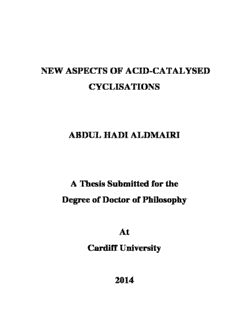
NEW ASPECTS OF ACID-CATALYSED CYCLISATIONS ABDUL HADI ALDMAIRI A Thesis ... PDF
Preview NEW ASPECTS OF ACID-CATALYSED CYCLISATIONS ABDUL HADI ALDMAIRI A Thesis ...
NEW ASPECTS OF ACID-CATALYSED CYCLISATIONS ABDUL HADI ALDMAIRI A Thesis Submitted for the Degree of Doctor of Philosophy At Cardiff University 2014 Declaration This work has not previously been accepted in substance for any degree and is not being concurrently submitted for candidature for any degree. Signed ………………………………………………… (Abdul Hadi Admairi) Date…………………………………………………… STATEMENT 1 This thesis is the result of my own investigations, except where otherwise stated. Other sources are acknowledged by footnotes giving explicit references. A bibliography is appended. Signed ………………………………………………… (Abdul Hadi Admairi) Date…………………………………………………… STATEMENT 2 I hereby give consent for my thesis, if accepted, to be available for photocopying and for inter- library loan, and for the title and summary to be made available to outside organisations. Signed ………………………………………………… (Abdul Hadi Admairi) Date…………………………………………………… ii Abstract This thesis describes the use of both sulfuric acid and triflic acid, to promote hydroamination and hydroalkoxylation cyclisations for the formation of N- and O- heterocycles. Chapter 2 describes the synthesis of 2,2,6-trisubstetuted piperidine. A wide range of protecting groups has been employed in the cyclisation. A new, general and flexible method for the highly enantioselective synthesis of chiral piperidine and spiro- piperidine has been developed. The main advantages of this synthetic method lie in the readily availability of the precursors. There is no reason why this reaction cannot find further application in natural product synthesis. Chapter 3 describes a miscellany of cascade and transannular cyclizations. The hydroamination has also been used to form the sterically crowded bridged isoquinuclidines through a transannular cyclisation, which would have rearranged to the less hindered products. We have also applied acid-catalyzed intramolecular cascade methodology to the synthesis of polycyclic hydroquinolines. Oxygen-centered transannular cyclisation has been compared with nitrogen-based examples, by acid-catalyzed hydroalkoxylation cyclisation to give only the sterically crowded bridged cineoles. Chapter 4 describes a new discovery of a novel N-to-O transfer reaction. iii Acknowledgements I would like to thank ‘my Boss’ Professor David W Knight for his great support and wisdom throughout my studies at Cardiff University. I have ever never seen like his beautiful mind. I would like to thank Damascaus University for financial support. I would also like to thank my wonderful lab friends Dr. Jessica Hatherley, Dr. Andy Smith, Dr. Ian King, Dr. Laura Henderson and Piotr Rutkowski. I must also acknowledge all the analytical and technical staff especially Dr Rob Jenkins, Robin, Dave, Gaz and Jamie for their hard work and help. Thanks to Dr. Kariuk for the X-ray crystal structures. I would also like to say a BIG thank you to my wife FATMA and my son ZIAD for their love and support throughout my life. iv Table of Contents DECLARATION......................................................................................................................... ii ABSTRACT.................................................................................................................................iii ACKNOWLEDGEMENTS........................................................................................................iv TABLE OF CONTENT............................................................................................................. v ABBREVIATIONS AND ACRONYMS................................................................................ vii CHAPTER 1: GENERAL INTRODUCTION..........................................................................1 Introduction…………….......................................................................................................1 Carbon-nitrogen bond synthesis...........................................................................................6 Intermolecular acid-catalyzed hydroamination of alkenes..................................................11 Intramolecular acid-catalyzed hydroamination of alkenes… .……………………………14 Acid-catalysed hydroamination reactions in the Knight group … .……………………16 Conclusion…………………………………………………………………………..……..22 References ……………………………………………………………………….………...23 CHAPTER 2: Acid-catalysed synthesis of piperidines . ……………................ …. 26 Piperdine synthesis .............................................................................................................26 How to make hindered piperidines .............................................................................. …..34 Spiro-piperidine................................................... ……………………………… …..64 Asymmetric synthesis of 2,2,6-trimethylpiperidine ................................................... …..66 Conclusion..........................................................................................................................70 References ………………… ………………………………………………….………..71 CHAPTER 3: Acid-catalyzed cyclisations in synthesis . .............................................. … 76 Introduction …………......................................................................................................76 v Cascade cyclisations..........................................................................................................76 Transannular cyclisations.................................................................................................87 Cyclisations of highly methylated cyclopentenyl carbamates and sulphonamides … …99 Acid-catalysed Hydroalkoxylation Cyclisations……………… .……………………..105 Conclusion.......................................................................................................................109 References …………………………………………………………...……..….…… 110 CHAPTER 4: A Novel N-to-O Rearrangement ................................... ........................... 113 CHAPTER 5: EXPERIMENTAL....................................................................................... 154 General experimental details......................................................................................... 154 General Procedures...........................................................................................................156 APPENDICES ................................................................................................................ 278 Appendix 1: 1-Toluenesulfonyl-2,2,6-trimethylpiperidine 237 ……………….………….. 279 Appendix 2: 2,2-Dimethyl-1-tosylpiperidine 250 ………………………………….…….. 281 Appendix 3: 1-(4-Nitrophenylsulfonyl)-2,2,6-trimethyl piperidine 261 ………………….. 283 Appendix 4: 1,3-Dimethyl-2-tosyl-2-azabicyclo[2.2.2]octane 420……………………….. 285 Appendix 5: 4,7-Dimethyl-6-((4-nitrophenyl)sulfonyl)-6-azabicyclo[3.2.1]octane 424…….287 Appendix 6: 1-Methyl-2-tosyl-2-azabicyclo[2.2.2]octane 430………………………...….. 289 Appendix 7: 4-Iodo-6-tosyl-6-azabicyclo[3.2.1]octane 436………………….. ……………291 Appendix 8: Methyl (1-methyl-2-oxabicyclo[2.2.2]octan-4-yl)methyl)carbamate 597……..293 vi Abbreviations and acronyms Ac acetyl app. apparent aq. aqueous Ar aromatic Bn benzyl b.p. boiling point br broad Bu butyl COSY correlation spectroscopy CI chemical ionisation d doublet DCM dichloromethane dd double doublet dt double triplet DEPT Distortionless Enhancement by Polarization Transfer DMF dimethylformamide DMSO dimethylsulfoxide e.e. enantiomeric excess EI electron ionisation eq. equivalent(s) ES electrospray vii ether diethyl ether Et ethyl ∆ heat h hour(s) HRMS high resolution mass spectrometry Hz hertz IR infra-red J coupling constant m multiplet M molar Me methyl MHz megahertz mol micromole(s) ml millilitre(s) mmol millimole(s) m.p. melting point MS mass spectrometry Ms methane sulfonyl NMR nuclear magnetic resonance NOSEY nuclear Overhauser enhancement spectroscopy Ns or nosyl p-nitrobenzenesulphonyl o ortho viii p. page p para Ph phenyl q quartet r.t. room temperature s singlet t triplet td triple doublet THF tetrahydrofuran TfOH/triflic acid trifluoromethanesulfonic acid TLC thin layer chromatography Ts toluenesulfonyl ix Chapter 1 Introduction
Description: